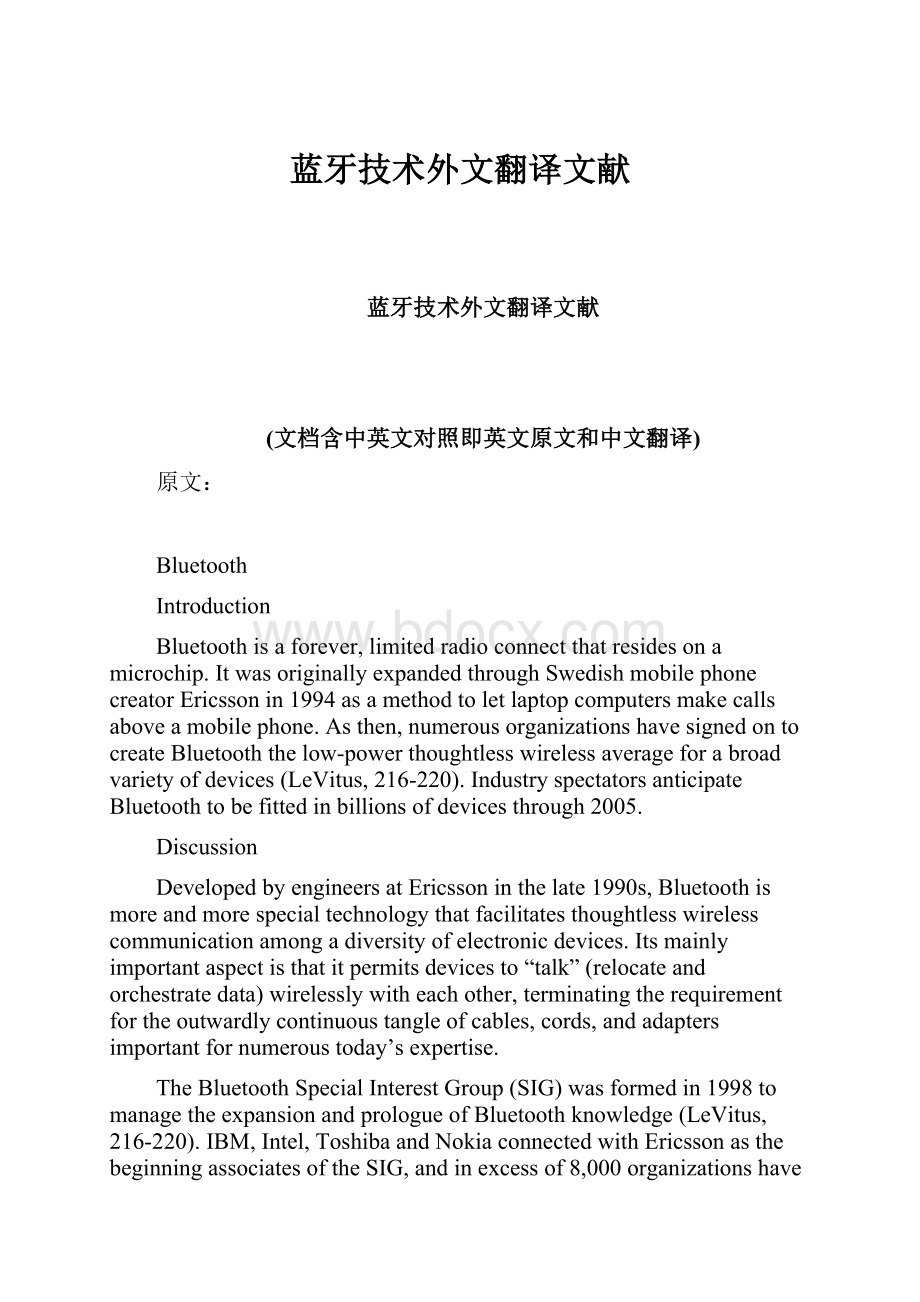蓝牙技术外文翻译文献.docx
《蓝牙技术外文翻译文献.docx》由会员分享,可在线阅读,更多相关《蓝牙技术外文翻译文献.docx(25页珍藏版)》请在冰豆网上搜索。

蓝牙技术外文翻译文献
蓝牙技术外文翻译文献
(文档含中英文对照即英文原文和中文翻译)
原文:
Bluetooth
Introduction
Bluetoothisaforever,limitedradioconnectthatresidesonamicrochip.ItwasoriginallyexpandedthroughSwedishmobilephonecreatorEricssonin1994asamethodtoletlaptopcomputersmakecallsaboveamobilephone.Asthen,numerousorganizationshavesignedontocreateBluetooththelow-powerthoughtlesswirelessaverageforabroadvarietyofdevices(LeVitus,216-220).IndustryspectatorsanticipateBluetoothtobefittedinbillionsofdevicesthrough2005.
Discussion
DevelopedbyengineersatEricssoninthelate1990s,Bluetoothismoreandmorespecialtechnologythatfacilitatesthoughtlesswirelesscommunicationamongadiversityofelectronicdevices.Itsmainlyimportantaspectisthatitpermitsdevicesto“talk”(relocateandorchestratedata)wirelesslywitheachother,terminatingtherequirementfortheoutwardlycontinuoustangleofcables,cords,andadaptersimportantfornumeroustoday’sexpertise.
TheBluetoothSpecialInterestGroup(SIG)wasformedin1998tomanagetheexpansionandprologueofBluetoothknowledge(LeVitus,216-220).IBM,Intel,ToshibaandNokiaconnectedwithEricssonasthebeginningassociatesoftheSIG,andinexcessof8,000organizationshavecontractedsince.SoastotradeproductswiththeBluetoothrequirementandlogo,manufacturersshouldbeassociatesoftheSIGandthedevicesshouldmeetwell-outlinedcredentials.TheseproceduresmakesurethatBluetoothwirelessdevicesinternationalmayconversewitheachother,apartfromcompanyornationofderivation.
SpeedandRange
RangeisapplicationspecificandalthoughaminimumrangeismandatedbytheCoreSpecification,thereisnotalimitandmanufacturerscantunetheirimplementationtosupporttheusecasetheyareenabling.
Rangemayvarydependingon classofradiousedinanimplementation:
∙Class3radios–havearangeofupto1meteror3feet
∙Class2radios–mostcommonlyfoundinmobiledevices,havearangeof10metersor33feet
∙Class1radios–usedprimarilyinindustrialusecases,havearangeof100metersor300feet
ThatcreatesBluetoothtechnologyappropriatefortransportinglesserfilesforexamplecellphonecontractsandtextdocuments,alsoaslower-qualitypicturesandaudio(Kumkum,160-162).Attheserelocatespeeds;Bluetoothmaynotactuallydealstreamingvideoorhigh-qualitypicturesandaudioatthisend,exceptthispossiblywillalterinthefuturewhenfreshBluetoothstandardsareinitiated.
SimpleandCompetenttoUtilize
CreatingandconfiguringBluetoothalloweddevicesismoderatelyuncomplicated,withlittleextracommotionthanacquirethetwodevicesclosetooneanotherandtwistthemon.Thereisnorequirementtomountdriversorfurthersoftwaretocomplexanad-hoc,personalwirelessnetwork(Kumkum,160-162).Ithasauniformorganization,meaningthatsometwowirelessproductsattributingBluetoothtechnology,despiteofproductornationoforigin,havetheabilitytoconversefaultlesslywitheachother.
CommonApplications
OneofthemainlyordinaryapplicationsofBluetoothishands-freecellphoneprocedure.AbouteachcellphonefashionedinourdayhasconstructedBluetooth(Meier,15-20).OnlypairphonewithaBluetoothheadset,andhemaytalkwhereashisphoneisinhispurseorpocket.Severaloftoday’scarstereosaswellhavefittedBluetoothforhands-freecallinginhisvehicle.Andifhisvehiclehasaplantstereoorgrown-upaftermarketonethathemerelydoesn’twishtorestore,hemayyetlikehands-freeidentifyingwithaBluetoothcarkit.
Bluetooth3.0
Bluetooth3.0isthefreshBluetoothwirelesstypicaladoptedthroughtheBluetoothSIGonApril21,2009.Thefreshstandardsupportselevateddataremovespeedsandconstructsaheadtheprecedingstandards(Meier,15-20).Withitssuperiorspeed,thetechnologyhastheprobabletotransfiguretheconsumerelectronicsindustry.
PROTOCOL
TheBluetoothtechnologystandardissettomakedifferentapplicationscan“communicate”witheachother.Remotedevicesincommunicationusethesameprotocolstacks,whiledifferentapplicationsneeddifferentprotocolstacks.But,everyapplicationneedsthedatalinklayerandphysicallayeroftheBluetoothtechnology.
ThewholeBluetoothprotocolstacksisshownasblow.Notanyapplicationshouldusealloftheprotocols,butoneorsomelistsofthese.Thechartbelowshowstherelationshipbetweenprotocols,buttherelationshipmaychangeinsomeapplications.
ThecompletelyprotocolstacksincludeBluetoothspecialprotocols(likeLMPandL2CAP)andnotspecialones(suchasOBEXandUDP).Thebasicprinciplefordesigningprotocolandprotocolstacksisthatuseexistinghighlevelprotocolaspossible,ensurethecombinationofprotocolsandBluetoothtechnology,andtakethebestadvantageofthesoftwareandhardwarewhichadapttotheBluetoothtechnologystandards.TheopenBluetoothtechnologymakesdevicemanufacturerscanchooseprotocolsfreelyastheylikeorusedto.
TheprotocolsinBluetoothprotocolsystem
TherearefourlayersinBluetoothprotocolsystemaccordingtotheSIG
∙Coreprotocols
∙Cablereplacementprotocols
∙Telephonycontrolprotocols
∙Adoptedprotocols
Excepttheprotocollayersabove,thestandardalsodefinesHost/ControllerInterface(HCI),whichprovidescommandinterfaceforbasebandcontroller,connectionmanager,hardwarestateandcontrolregister.
BluetoothcoreprotocolsconsistofthespecialprotocolsmadebySIG.MostBluetoothdevicesneedcoreprotocols,whileotherprotocolsareuseddependonneedsoftheapplication.Afterall,cablereplacementprotocols,technologycontrolprotocolsandadoptedprotocolsbasedonthecoreprotocolsconstitutetheobject-orientedprotocols.
∙Coreprotocols
∙LMP(LinkManagementProtocol)
Usedforcontroloftheradiolinkbetweentwodevices.Implementedonthecontrollers.
Itidentifiesandencryptsthroughlaunching,exchangingandcheckingtheconnection,anddecidesthesizeofbasebanddatapacketsthroughconference.Italsocontrolsthepowermodeandworkcycleofwirelessequipment,andconnectionstatusofunitequipmentinpiconet.
∙L2CAP(LogicalLinkControl&AdaptationProtocol)
Thisprotocolisusedtomultiplexmultiplelogicalconnectionsbetweentwodevicesusingdifferenthigherlevelprotocols,andprovidessegmentationandreassemblyofon-airpackets.
InBasicmode,L2CAPprovidespacketswithapayloadconfigurableupto64kB,with672bytesasthedefaultMTU,and48bytesastheminimummandatorysupportedMTU.
InRetransmission&FlowControlmodes,L2CAPcanbeconfiguredforreliableorisochronousdataperchannelbyperformingretransmissionsandCRCchecks.
BluetoothCoreSpecificationAddendum1addstwoadditionalL2CAPmodestothecorespecification.ThesemodeseffectivelydeprecateoriginalRetransmissionandFlowControlmodes:
∙EnhancedRetransmissionMode(ERTM):
Thismodeisanimprovedversionoftheoriginalretransmissionmode.ThismodeprovidesareliableL2CAPchannel.
∙StreamingMode(SM):
Thisisaverysimplemode,withnoretransmissionorflowcontrol.ThismodeprovidesanunreliableL2CAPchannel.
Reliabilityinanyofthesemodesisoptionallyand/oradditionallyguaranteedbythelowerlayerBluetoothBDR/EDRairinterfacebyconfiguringthenumberofretransmissionsandflushtimeout(timeafterwhichtheradiowillflushpackets).In-ordersequencingisguaranteedbythelowerlayer.
OnlyL2CAPchannelsconfiguredinERTMorSMmaybeoperatedoverAMPlogicallinks.
∙SDP(ServiceDiscoveryProtocol)
ServiceDiscoveryProtocol(SDP)allowsadevicetodiscoverservicessupportedbyotherdevices,andtheirassociatedparameters.Forexample,whenconnectingamobilephonetoaBluetoothheadset,SDPwillbeusedfordeterminingwhichBluetoothprofilesaresupportedbytheheadset(HeadsetProfile,HandsFreeProfile,AdvancedAudioDistributionProfile(A2DP)etc.)andtheprotocolmultiplexersettingsneededtoconnecttoeachofthem.EachserviceisidentifiedbyaUniversallyUniqueIdentifier(UUID),withofficialservices(Bluetoothprofiles)assignedashortformUUID(16bitsratherthanthefull128)/vichitra
∙Cablereplacementprotocols(RFCOMM)
Radiofrequencycommunications(RFCOMM)isacablereplacementprotocolusedtocreateavirtualserialdatastream.RFCOMMprovidesforbinarydatatransportandemulatesEIA-232(formerlyRS-232)controlsignalsovertheBluetoothbasebandlayer.
RFCOMMprovidesasimplereliabledatastreamtotheuser,similartoTCP.ItisuseddirectlybymanytelephonyrelatedprofilesasacarrierforATcommands,aswellasbeingatransportlayerforOBEXoverBluetooth.
∙Telephonycontrolprotocols(TCP).
Telephonycontrolprotocol-binary(TCSBIN)isthebit-orientedprotocolthatdefinesthecallcontrolsignalingfortheestablishmentofvoiceanddatacallsbetweenBluetoothdevices.Additionally,"TCSBINdefinesmobilitymanagementproceduresforhandlinggroupsofBluetoothTCSdevices."
TCS-BINisonlyusedbythecordlesstelephonyprofile,whichfailedtoattractimplementers.Assuchitisonlyofhistoricalinterest.
∙Adoptedprotocols
Adoptedprotocolsaredefinedbyotherstandards-makingorganizationsandincorporatedintoBluetooth’sprotocolstack,allowingBluetoothtocreateprotocolsonlywhennecessary.Theadoptedprotocolsinclude:
∙Point-to-PointProtocol(PPP):
InternetstandardprotocolfortransportingIPdatagramsoverapoint-to-pointlink.
∙TCP/IP/UDP:
ForcommunicatingwiththedeviceconnectedtoInternet.
∙ObjectExchangeProtocol(OBEX):
Session-layerprotocolfortheexchangeofobjects,providingamodelforobjectandoperationre